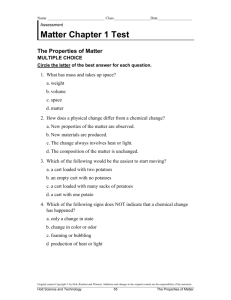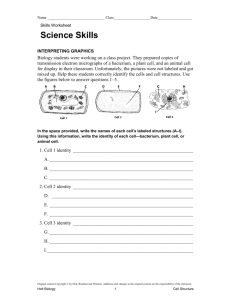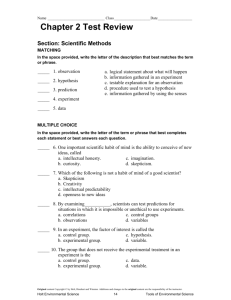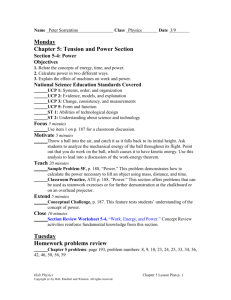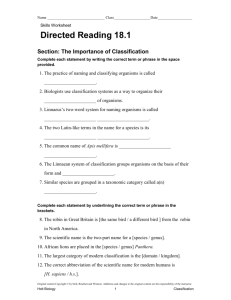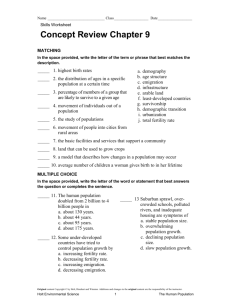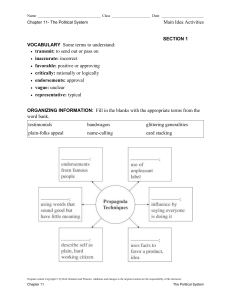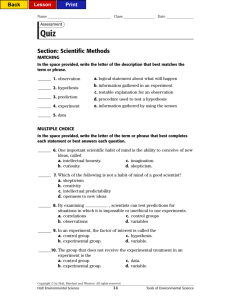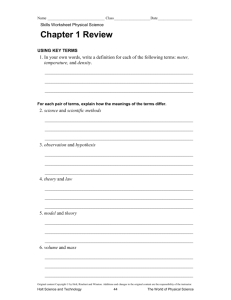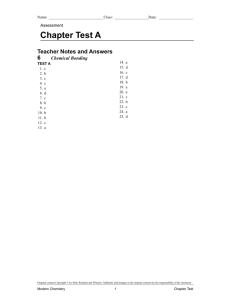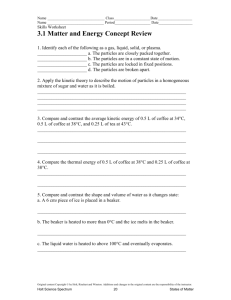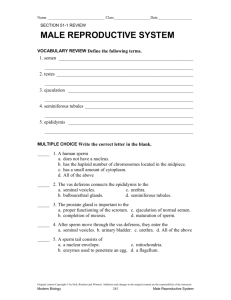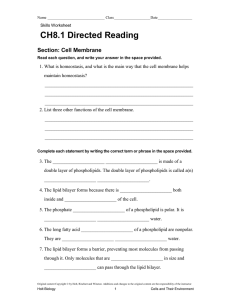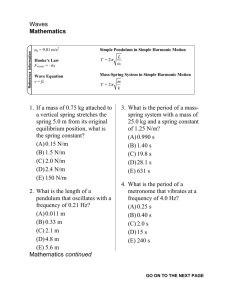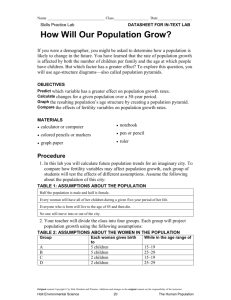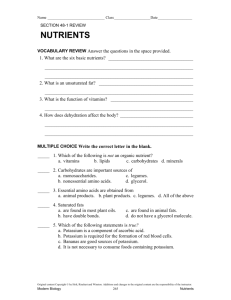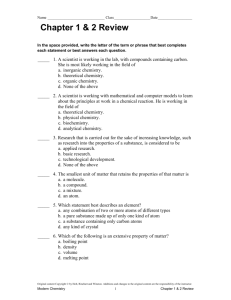Document
advertisement
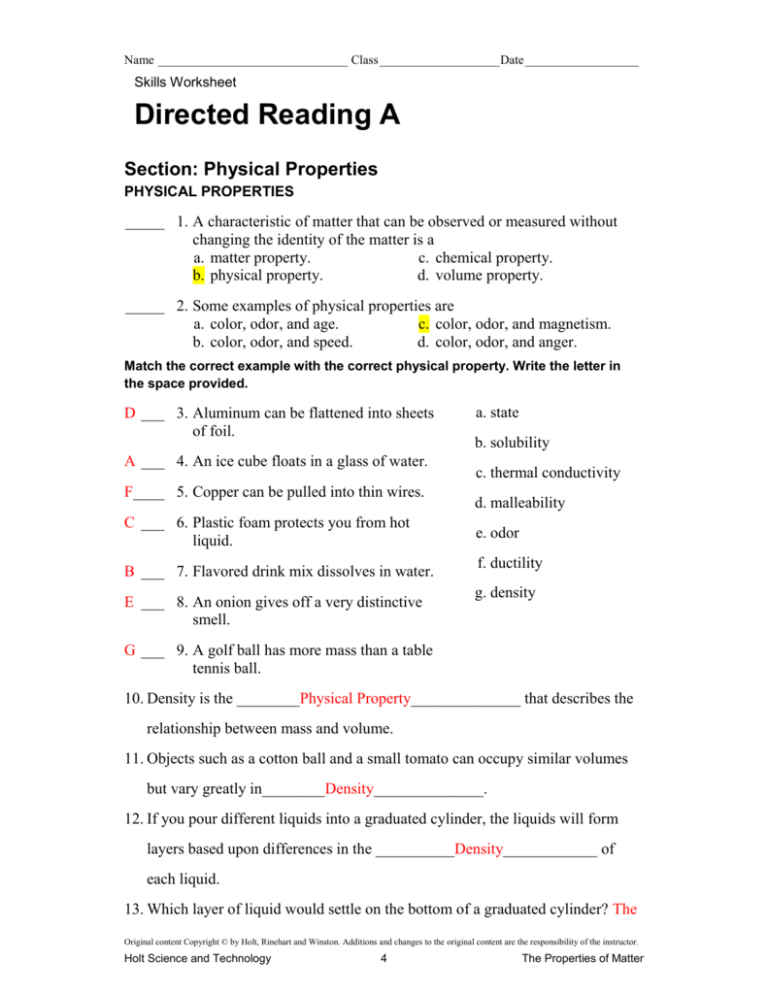
Name ______________________________ Class ___________________ Date __________________ Skills Worksheet Directed Reading A Section: Physical Properties PHYSICAL PROPERTIES _____ 1. A characteristic of matter that can be observed or measured without changing the identity of the matter is a a. matter property. c. chemical property. b. physical property. d. volume property. _____ 2. Some examples of physical properties are a. color, odor, and age. c. color, odor, and magnetism. b. color, odor, and speed. d. color, odor, and anger. Match the correct example with the correct physical property. Write the letter in the space provided. D ___ 3. Aluminum can be flattened into sheets of foil. A ___ 4. An ice cube floats in a glass of water. F____ 5. Copper can be pulled into thin wires. C ___ 6. Plastic foam protects you from hot liquid. B ___ 7. Flavored drink mix dissolves in water. E ___ 8. An onion gives off a very distinctive smell. a. state b. solubility c. thermal conductivity d. malleability e. odor f. ductility g. density G ___ 9. A golf ball has more mass than a table tennis ball. 10. Density is the ________Physical Property______________ that describes the relationship between mass and volume. 11. Objects such as a cotton ball and a small tomato can occupy similar volumes but vary greatly in________Density______________. 12. If you pour different liquids into a graduated cylinder, the liquids will form layers based upon differences in the __________Density____________ of each liquid. 13. Which layer of liquid would settle on the bottom of a graduated cylinder? The Original content Copyright © by Holt, Rinehart and Winston. Additions and changes to the original content are the responsibility of the instructor. Holt Science and Technology 4 The Properties of Matter Name ______________________________ Class ___________________ Date __________________ densest layer will settle on the bottom Directed Reading A continued 14. Where will the least dense liquid be found? The least dense layer will be found on top. _____________________________ 15. Why would 1 kg of lead be less awkward to carry around than 1 kg of feathers? 1 kg of lead would take up less space than 1 kg of feathers ________________ _______________________________________________________________ _______________________________________________________________ 16. What will happen to a solid object made from matter with a greater density than water when it is dropped into water? The object will sink. ______________________________________________ 17. How will knowing the density of a substance help you determine whether an object made from that material will float in water? If you know the density of the substance, you could compare it with the density of water. If the density of the object is less than the density of water it will float. _______________________________________________________________ 18. What is the equation for density? Mass divided by the Volume ________________________________________ 19. What do D, V, and m stand for in the equation for density? D = density, V = volume , m = mass __________________________________ 20. The units for density take the form of a mass unit divided by a(n) __________Volume____________unit. 21. What are two reasons why density is a useful property for identifying substances? A substance’s density is always the same at a given temperature and pressure and because most substances have different densities ____________________ _______________________________________________________________ Original content Copyright © by Holt, Rinehart and Winston. Additions and changes to the original content are the responsibility of the instructor. Holt Science and Technology 5 The Properties of Matter Name ______________________________ Class ___________________ Date __________________ Directed Reading A continued PHYSICAL CHANGES DO NOT FORM NEW SUBSTANCES 22. A change that affects only the physical properties of a substance is known as a(n) __________physical Change____________ 23. What kind of changes are melting and freezing? Changes in state __________________________________________________ Identify which of the following activities represent physical changes by writing PC in the space provided if they cause only physical changes. Put an X beside any that do not. PC __ 24. sanding a piece of wood X ___ 25. baking bread PC __ 26. crushing an aluminum can PC __ 27. melting an ice cube PC __ 28. dissolving sugar in water PC __ 29. molding a piece of silver 30. When a substance undergoes a physical change, its __________identity____________does not change. 31. What is changed when matter undergoes a physical change? Give an example to explain your answer. Just it’s state, such as going from a liquid to a gas. ______________________ _______________________________________________________________ _______________________________________________________________ _______________________________________________________________ _______________________________________________________________ _______________________________________________________________ _______________________________________________________________ Original content Copyright © by Holt, Rinehart and Winston. Additions and changes to the original content are the responsibility of the instructor. Holt Science and Technology 6 The Properties of Matter


